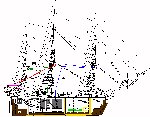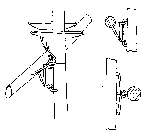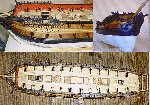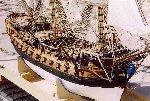This page informs about the model of HMS Leopard.
Based on this book I started to built my 1:72 model of HMS Leopard. "Charting its origins in the pre-Commonwealth 'frigates', the author follows the development of the type in the eighteenth century and its gradual transition from battlefleet to heavy cruiser role, highlighting its revival for the special conditions of colonial warfare during the American Revolution. Thereafter, they where employed as peacetime flagships for distant stations, but achieved a final glory leading small craft in anti-invasion operations during Napoleonic War." Chatham Publishing |
|
Part of the above mentioned book is very nice drawn plan set of HMS Leopard, drawn by John McKay. Based on this plans I build my model. For the rigging, not so detailed shown within these plans, I strongly recommend "18th Century Rigs and Rigging" by Karl Heinz Marquardt. Very detailed description with tons of pics, how to rig a ship of this period. You can get these books at John Bergs Sea Room |
|
Having some experience in static modelling of sailing ships, this was my first radio controlled one. To have a good access to the mechanical components of the controls later on, I decided to split the hull horizontally. Access just by some hatches in the deck seemed not sufficient enough to me. This would be also very difficult due to the amount of rigging for such a ship. Because lot of the rigging is attached at the ships side, splitting would be very close to the water line with an expected leakage problems. So I decided to have the internal sealing surface a bit higher. See cross section beside. All controls are attached to the upper part of the hull. The lower deck has just half guns in small holes, the upper battery is equipped with complete guns. |
|
The lower part of the hull in top view. Note the blue sealing lip. The hull is completely built from wood with double planking. |
|
Side view of the lower hull part. Note the difference between water line, separation line (following the planking) and sealing surface. |
|
The upper part of the ship. Two batteries, one for radio and one for the sail wrenches. The 4 wrenches can control independent from each other the square sails of fore, main and mizzen mast and the spanker. Square sails are adjusted by moving the lower yards by their braces. Manual the studden and royal sails can be added or removed, the top and topgallant yards can be lowered and all sails can be reefed. |
|
Detailed view of the sail wrench arrangement. Right the servo for the rudder. |
|
 |
Arrangement of components inside the hull. |
 |
Truss of the lower yards. Made by copper wire. |
 |
Under construction. |
To operate a model of that scale, you need to move the ballast lower than scale, means you need to add a keel. Also the surface of the rudder needs to be increased. These items can be removed for static display. |
|
Detail view of the foremast and foretop. |
|
 |
View of the forecastle. |
 |
Overall view of the hull. |